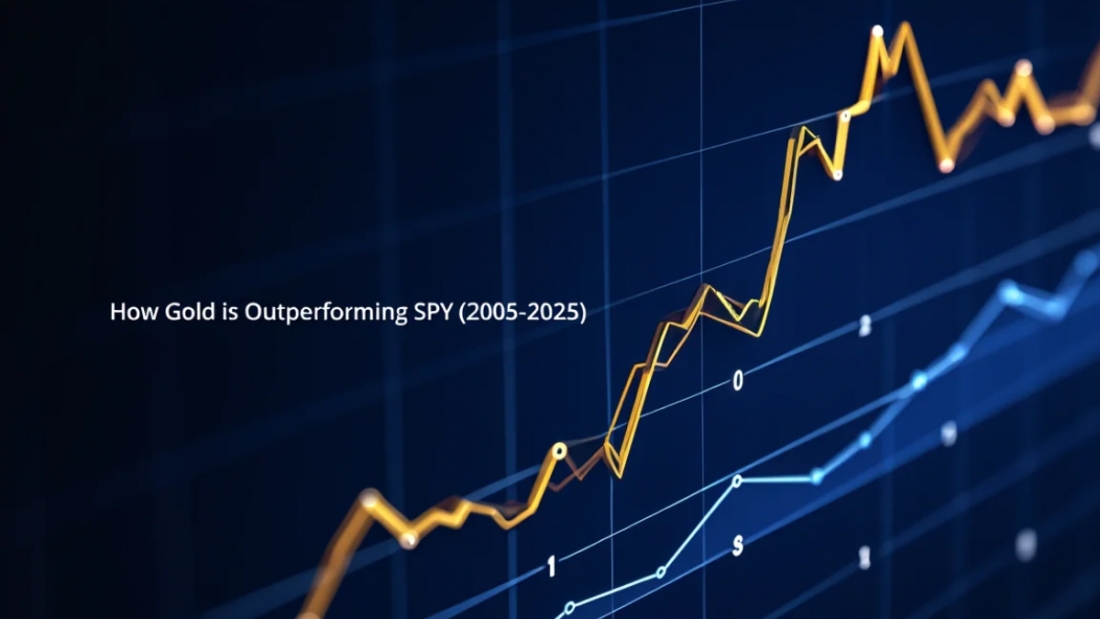Over the last two decades, investors have grappled with shifting economic tides, volatile markets, and an increasingly complex global financial system. One recurring question: Has gold outperformed the general market?
To answer this, we looked at the total return of the SPDR S&P 500 ETF (SPY) which includes dividends reinvested and compared it to the performance of spot gold prices from 2005 through early 2025.
Since SPDR Gold ETF (GLD) launched in Nov 2004…
— Nate Geraci (@NateGeraci) April 18, 2025
GLD +589%
SPY +551%
VNQ +291%
EEM +196%
EFA +183%
AGG +90%
TLT +81%
Gold has outperformed nearly every major asset class. pic.twitter.com/Q7s2FDjdZz
Cumulative Performance (2005–2025)
Gold (Spot Price): +552.94%
SPY (Total Return with Dividends): +535.63%
On the surface, it appears that gold has slightly outperformed SPY over the 20-year period. But the path each asset took to get here tells a much more nuanced story.
The Path to 2025: A Tale of Two Assets
In the early 2000s, gold surged. From 2005 to 2011, it nearly tripled in price, fueled by inflation fears, global economic uncertainty, and the 2008 financial crisis. While SPY plunged nearly 37% in 2008, gold rose 3.97%, acting as a perceived safe haven in the storm.
From 2012 to 2018, however, gold’s momentum slowed. It suffered a major drop in 2013 (–27.6%) and remained mostly flat or negative for several years. Meanwhile, SPY roared back from the Great Recession, driven by low interest rates, a tech boom, and steady economic growth. By 2019, SPY had caught up to and slightly overtaken gold in total returns.
But the COVID-19 pandemic shook markets again. In 2020, both gold and SPY surged—gold as a hedge against chaos, SPY as a bet on recovery and innovation. From 2021 to 2023, SPY continued its climb, but by 2024 and into early 2025, both assets faced new turbulence.
In 2025, gold has once again taken the lead, aided by renewed volatility, geopolitical uncertainty, and inflation concerns. SPY has dropped roughly 10% year-to-date, while gold is up more than 8%.
India and China by far largest buyers of gold in 2024. India led in jewellery purchases with 560 tonnes (70% of it for the country’s 10 million weddings) while China led in bars for central bank at 345 tonnes.
— Trung Phan (@TrungTPhan) April 17, 2025
India, China, Thailand, Vietnam and Indonesia bought 65% of all gold. pic.twitter.com/NFK6QSQ0Hj
Central Banks and the Gold Resurgence
One major driver of gold’s recent strength has been unprecedented central bank buying. Over the past few years, central banks around the world, especially in emerging markets, have been accumulating gold at record levels. According to the World Gold Council, 2022 and 2023 marked the highest levels of annual gold purchases by central banks in decades. Nations like China, Turkey, and India have increased their reserves in an effort to diversify away from the U.S. dollar and fortify their financial systems against geopolitical risk.
This institutional demand has created a significant price floor for gold and added upward pressure even during periods when retail investors were less active. These purchases aren’t short-term trades; they’re long-term strategic moves, signaling gold’s enduring role as a reserve asset in a rapidly deglobalizing world.
At the same time, SPY has undergone several significant corrections, notably in 2022, when it fell over 18%, and again in early 2025, where year-to-date losses are already approaching 10%. These pullbacks have coincided with rising interest rates, sticky inflation, and broader geopolitical instability, all of which have boosted gold’s appeal as a stable store of value.
You want to know why #gold has been going up? Because the global money supply (M2) has been shooting up. Governments are printing as fast as they know how, and it's still not enough.
— Chris Martenson (@chrismartenson) April 20, 2025
Full report: https://t.co/fcdUHaZjwv pic.twitter.com/aithwUABdO
Inflation, Currency Debasement, and the Flight to Gold
Beyond volatility and market cycles, a deeper economic concern is also playing out: the debasement of major fiat currencies.
In the United States, record fiscal deficits, aggressive monetary stimulus, and a decade of ultra-low interest rates have raised concerns about the long-term purchasing power of the dollar. Inflation, once considered transitory, has proven persistent. Although it has cooled from its 2022 peak, consumers and investors alike continue to feel the sting of higher prices. This erosion of trust in fiat purchasing power has made gold more attractive as a hedge against monetary expansion.
Meanwhile, in China, economic pressures and a weakening yuan have pushed both domestic and international actors to seek refuge in hard assets. With capital controls in place and investor confidence wavering due to real estate turmoil and slowing growth, gold has become one of the few perceived safe stores of value accessible to Chinese savers and institutions.
Across both economies, the story is similar: when confidence in currency weakens, gold tends to strengthen. It’s not just about inflation; it’s about trust. And gold, with centuries of historical credibility, is benefiting from the erosion of that trust in fiat money.
Why Gold? Perceived Safety in a Volatile World
In highly volatile environments, investors gravitate toward what they perceive as safe. Gold has no earnings, pays no dividend, and does not benefit from innovation or productivity growth—yet it continues to attract capital during crises.
Its allure lies in stability, scarcity, and a long-standing reputation as a store of value. When the world feels uncertain, gold feels familiar. Investors seek safety not just in numbers, but in narratives—and gold has one of the strongest stories in the financial world.
The Bigger Picture
While gold may have narrowly edged out SPY over this 20-year span, it’s worth noting that stocks—especially those in the S&P 500—have delivered powerful compounding returns with more consistent long-term growth.
Gold shines brightest during periods of fear, inflation, or crisis. SPY thrives during economic expansion and innovation. The contrast is clear: one asset preserves, the other grows.



Leave A Comment